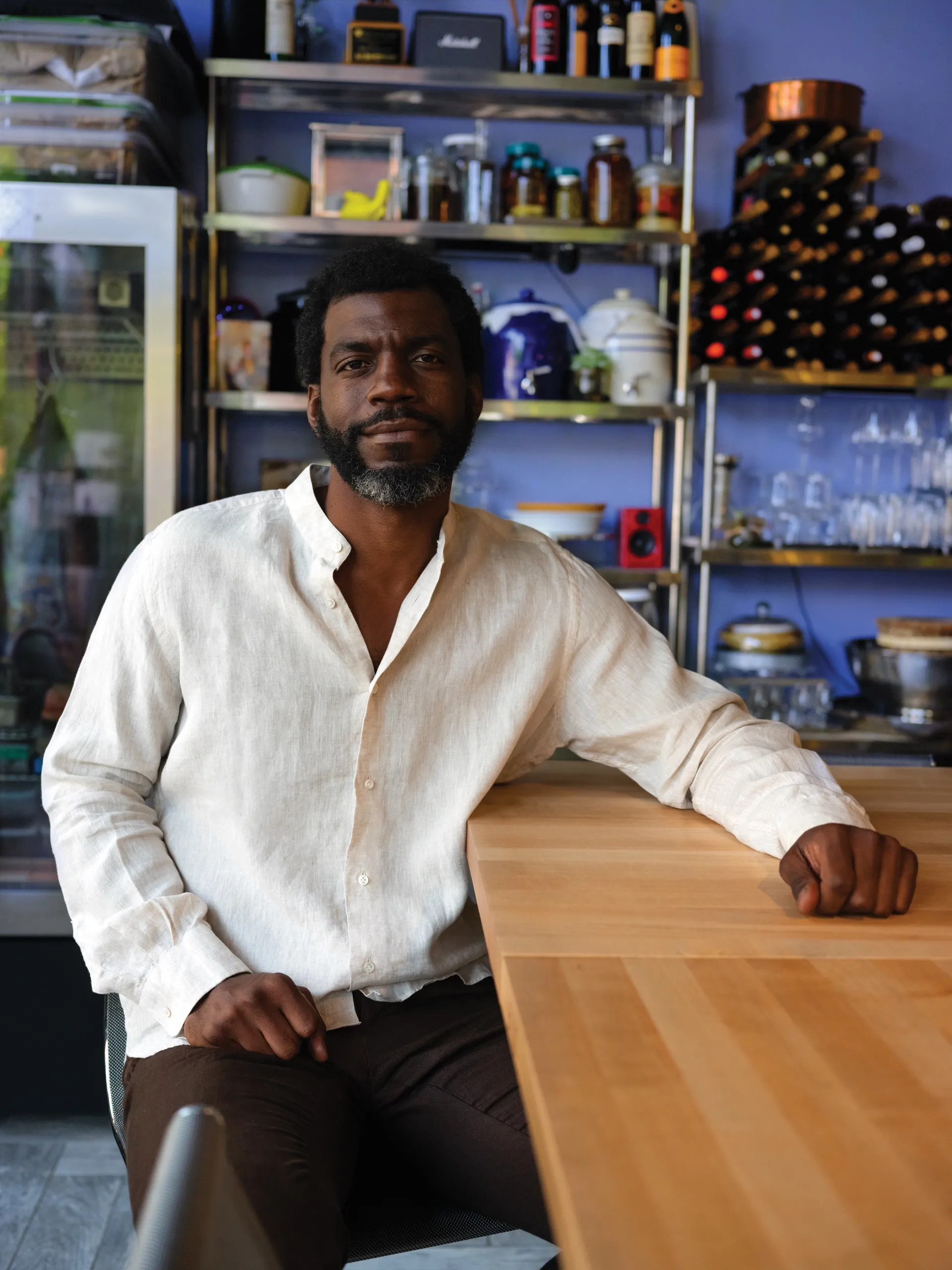Stephen Satterfield, the host of the Netflix food-history series “High on the Hog,” was bent over the stove in his parents’ kitchen, near Atlanta. It was one o’clock on a February afternoon, and he was preparing Sunday dinner for the family. Most of the meal was canonical Black Southern food: turnip greens simmered for hours, cheese grits, biscuits baked in a cast-iron skillet. The main course was catfish, coated in cornmeal and sizzling in avocado oil. The fish, though, had a widely disputed accompaniment. With a dimpled smile, Satterfield lifted a lid to reveal a pot full of spaghetti and tomato sauce.
Depending on whom you ask, this combination is either as congenial as shrimp and grits or as regrettable as a bad marriage. The food writer Adrian Miller once noted, “It may be the most controversial soul food coupling since someone decided it was a good idea to marinate dill pickles in Kool-Aid.” Satterfield, who is thirty-nine, first encountered the dish as a family tradition: in Mississippi, where his maternal grandmother was born, the river was full of catfish, and spaghetti was cheap. In 1946, she and his grandfather followed the Great Migration route north to Gary, Indiana. When Stephen was growing up, his father often fixed catfish and spaghetti for Sunday dinners and for church fish fries.
Satterfield didn’t realize the pairing’s wider significance until he was getting ready for an episode of “High on the Hog,” which refracts the history of the United States through the lens of Black food. Miller, who appears in the series, had an explanation: catfish and spaghetti originated in the Deep South in the late eighteen-hundreds, as Italian immigrants settled in Mississippi and Louisiana. Black Southerners adopted spaghetti, and came to consider it, like coleslaw or potato salad, a pleasing side dish to fried fish.
This is what Satterfield calls a good origin story: an unexpected confluence of historical streams. There are countless others. Peanuts, a key ingredient in West African stews, got their American nickname, goobers, from the Bantu word nguba. George Washington’s Presidential kitchen was run by an enslaved man named Hercules, until he escaped servitude and vanished.
Such stories about the African diaspora’s influences on American cuisine are disclosed in rich detail by Jessica B. Harris in the 2011 book “High on the Hog”—the basis for the show. Produced and directed almost entirely by African Americans, the series features Black chefs, pitmasters, historians, farmers, entrepreneurs, and cookbook writers discussing their heritages and creating delectable meals. Satterfield presides like an unusually solicitous reporter: he listens intently as his guests excavate buried histories and lends a hand as they cook.
At his parents’ house, Satterfield, a bearded, loose-limbed six feet five, had a sous-chef: his girlfriend, Gabriella Oviedo, a writer who also collaborates on his business. But, having spent his twenties training at high-end restaurants, he had things under control. Half a dozen family members milled hungrily around the living room, until Satterfield’s father, Sam, returned from church. Familiar with his son’s self-described “bougie tastes,” Sam apparently expected a showy meal, but he was pleasantly surprised. “Stephen!” he exclaimed. “You made catfish and spaghetti!”
Harris sometimes cites an African proverb: “When the tale of the hunt is written by the lion, it will be a very different tale.” With the series, Satterfield and his partners wanted to upend Americans’ view of their history. They knew how difficult it would be to do that in four episodes, beginning in the slave markets of West Africa and tracing centuries of suffering and transcendence in the United States. But Satterfield trusted in the seductive power of good cooking: “How do you get away with it if it’s not about food?” In the second episode, “The Rice Kingdom,” the culinary historian Michael Twitty prepares okra-and-crab soup at the Magnolia Plantation, outside Charleston. “Despite the fact that we were in Hell . . . that we were being worked to death,” he said, “we created a cuisine.” This food, he noted, was named for the soul—“something invisible that you could feel, like love and God.”
“High on the Hog” débuted when many Americans were in an unusually reflective mood, after the George Floyd murder and a year into the pandemic. Justin Kirkland, in Esquire, called the series “revolutionary.” In the Times, Osayi Endolyn wrote, “It hits the eye, mind and soul differently than any other food television program,because it simply does what so few have been willing to do: give Black people space to explore and express our own joy.” The series, whose second season will be released this fall, is available in a hundred and ninety countries, with subtitles in Portuguese, Arabic, and twenty-nine other languages. Satterfield said, “It proved my thesis: food is the most efficient means of helping people to see themselves.”
The city of Gary isn’t much to look at these days. In its prime, it contained one of North America’s biggest steel plants, the Gary Works, which employed tens of thousands of people. But half a century after white flight and deindustrialization, the formerly booming business district consists mostly of razed lots, boarded-up storefronts, and decrepit buildings. Satterfield describes Gary as “the literal embodiment of the deflation of a dream.” So when he visited last year with his sister Ashley he was surprised to spot Bugsy’s Tavern, a busy watering hole with a cheerful Bugs Bunny knockoff on the roof. “It defies explanation,” he said—a white-owned biker bar near the old color line. “It’s a neutral gathering zone, in a mostly Black city.”
During my visit, we pulled into the parking lot of Bugsy’s. Satterfield warned me, “There’s a lot of smoking. You’ll want to wash your clothes afterward.” A casually snappy dresser, he had arrived in cashmere trousers. “I’m going to do my change of wardrobe now,” he said, and slipped on a cotton hoodie and quilted navy sweats.
During my visit, we pulled into the parking lot of Bugsy’s. Satterfield warned me, “There’s a lot of smoking. You’ll want to wash your clothes afterward.” A casually snappy dresser, he had arrived in cashmere trousers. “I’m going to do my change of wardrobe now,” he said, and slipped on a cotton hoodie and quilted navy sweats.
Ashley, a bartender at Atlanta’s old Colonnade restaurant, is Stephen’s closest companion, and the family’s self-appointed deflater of egos. (When I asked if Stephen did any cooking as a kid, she rolled her eyes and said, “He always burned things.”) She is also the historian for an extensive clan. When she was a girl, she liked nothing better than listening to her elders’ stories.
Gary was established in 1906, by a subsidiary of the United States Steel Corporation; newspaper stories lured Black Southerners and European immigrants to the Magic City of Steel. When Sam was a child, in the fifties, Gary was known for its innovative schools, striking architecture, and rapid economic growth. It was also segregated, with an invisible barrier that Sam’s siblings wouldn’t cross. As a young man, Sam worked at the mill, as a switchman for railcars that moved giant vats of molten steel. Men lost limbs and suffered hideous burns, but employees earned what Sam called “crazy money,” and many Satterfields thought of Gary as “the best place in the world.” Sam knew that it couldn’t last. One day, as he watched a ship being unloaded, he noticed crates marked “Product of China,” and realized, “This is all collapsing.” He embarked on a reverse migration, moving to Atlanta in 1976.
Inside Bugsy’s, the walls and ceiling were hung with Harley-Davidson paraphernalia, road signs, and posters advertising Bike Night and Ladies’ Night. Aging bikers sat around, absorbed in their cigarettes and longnecks. Most observed us with mild curiosity, but one bandy-legged man with lank gray hair ambled over unsteadily. Pointing to the jukebox, he said, “I played all these great songs.” Then he informed us that he was an undercover agent for the C.I.A., and staggered off.
On a barstool, beer in hand, Stephen talked about Black Americans’ fraught relationship to land and food. For centuries, they had no way to own the farms they worked: “Cotton was for capital. We’re basically still there, in a slightly altered form—displacement and disenfranchisement through Reconstruction, Jim Crow, redlining, gentrification.”
Earlier, we had visited the ruins of the Satterfield homestead, bushwhacking through thorny weeds to the foundation of the house that Sam’s father built. Ashley pointed to the place where their grandparents had tended a vegetable garden, which, along with squirrels and rabbits caught by Sam’s uncles, helped feed their large family. At the bar, Stephen said, “Our dad grew up with a garden. Our mom grew up with a garden. Our grandparents grew their own food.” In talks, he often mentions Black farmers who raise fresh produce in food deserts, “so that we can reclaim our health.” Ashley interjected, “But a lot of people say, ‘I don’t have to do that anymore.’ ” Stephen nodded: “Our mom believed, ‘We’ve worked our asses off so that you don’t have to toil in the field.’ ”




